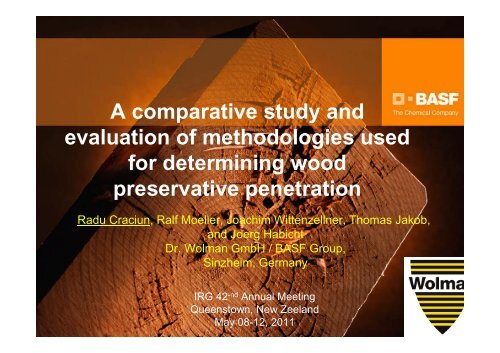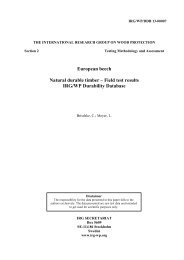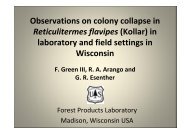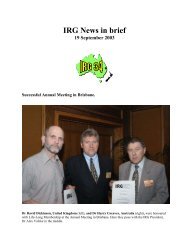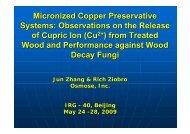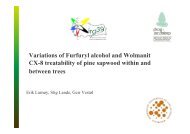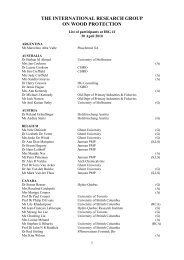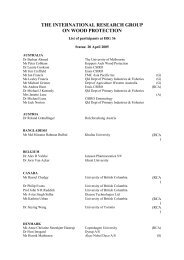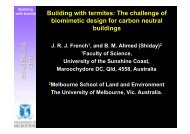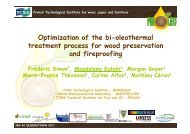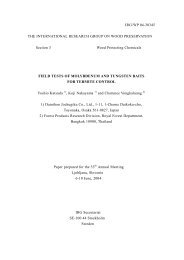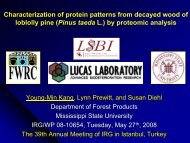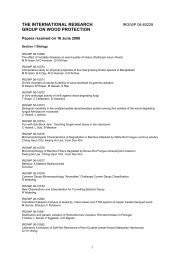A comparative study and evaluation of methodologies used for ...
A comparative study and evaluation of methodologies used for ...
A comparative study and evaluation of methodologies used for ...
Create successful ePaper yourself
Turn your PDF publications into a flip-book with our unique Google optimized e-Paper software.
A <strong>comparative</strong> <strong>study</strong> <strong>and</strong><br />
<strong>evaluation</strong> <strong>of</strong> <strong>methodologies</strong> <strong>used</strong><br />
<strong>for</strong> determining wood<br />
preservative penetration<br />
Radu Craciun, Ralf Moeller, Joachim Wittenzellner, Thomas Jakob,<br />
<strong>and</strong> Joerg Habicht<br />
Dr. Wolman GmbH / BASF Group,<br />
Sinzheim, Germany<br />
IRG 42-nd Annual Meeting<br />
Queenstown, New Zeel<strong>and</strong><br />
May 08-12, 2011<br />
18.03.2009 INTERN 1
18.03.2009<br />
Key steps <strong>for</strong> evaluating new wood<br />
preservative systems<br />
Treatment<br />
Process<br />
Environment/<br />
exposure<br />
conditions<br />
Chemical<br />
stability<br />
Efficacy - wood protection<br />
Biostability/<br />
bio<br />
degradation<br />
Fixation/<br />
Leaching<br />
INTERN<br />
Penetration<br />
UV stability/<br />
weathering<br />
2
18.03.2009<br />
Overview – why penetration studies ?<br />
� Review various method to determine the wood<br />
preservative/product penetration into the core part <strong>of</strong> the<br />
wood:<br />
- Indirect color indicator/tracers,<br />
- Direct treating solution uptake<br />
- Gradient analysis: solvent<br />
extraction/chromatography analysis<br />
- Laboratory microbiology methods/what really works!<br />
� Correlation studies between various methods <strong>used</strong> in<br />
penetration studies (color vs. gradient vs. microbiology)<br />
� Concluding remarks/what the industry needs !?<br />
INTERN<br />
3
18.03.2009<br />
Indirect penetration color indicator<br />
- copper/quat/other additives/traces pr<strong>of</strong>iles -<br />
(A) <strong>for</strong> -a Br-phenol quat-based <strong>for</strong> system, quats (a) <strong>and</strong> Cr-azurol (B) <strong>for</strong> <strong>for</strong>acopper copper (b); based <strong>and</strong> other system,<br />
indicators <strong>for</strong> Cu-modified systems (c - other type <strong>of</strong> matrix)<br />
(a)<br />
(b)<br />
INTERN<br />
4
Direct gradient analysis<br />
- Solvent extraction/chromatography at various depths -<br />
18.03.2009<br />
(a) Scots pine wood blocks <strong>used</strong> in this penetration <strong>study</strong>.<br />
(b) Cross sections <strong>of</strong> the wood blocks showing the marked<br />
analytical zones (A, C) <strong>and</strong> the sealed cross section (B).<br />
(a) (b)<br />
- Wood grinding corresponding to each zone followed by solvent<br />
extraction or acid digestion<br />
- AAS/ICP <strong>for</strong> metal analysis (Cu, B, As) or HPLC/GC <strong>for</strong> organic<br />
biocides (e.g. tri-azoles) in metal-organic systems<br />
INTERN<br />
5
Test set up: wafers taken <strong>for</strong> ende sealed pine boards samples (20 x 4<br />
x 4 cm³) DV or VPT impregnated. Wafer cut out from the centre <strong>of</strong> the<br />
treated wood (as shown in the picture below).<br />
•<br />
18.03.2009<br />
Direct microbiology penetration method<br />
- methodology setup/test design -<br />
40 mm<br />
40 mm<br />
Samples <strong>for</strong> EN 113<br />
Petri dish<br />
fungal mycelium<br />
growth medium<br />
200 mm<br />
EN113 EN113<br />
fungi fungi<br />
analytics<br />
wood<br />
section<br />
sample holder<br />
INTERN<br />
Cross sections sealed<br />
Samples <strong>for</strong> screening II<br />
6
Microbiology penetration method<br />
- results from various types <strong>of</strong> fungi <strong>used</strong> in the test -<br />
18.03.2009<br />
(a) P.p. exposed treated wafers with Cu-based <strong>and</strong> organic systems<br />
(b) Exposed untreated control wafer<br />
(c) Exposed <strong>and</strong> dreid untreated control wafer<br />
(a)<br />
(b)<br />
(c)<br />
INTERN<br />
7
18.03.2009<br />
Indirect penetration color indicator<br />
- copper pr<strong>of</strong>ile in modified systems -<br />
(A) <strong>for</strong> a- quat-based Cr-azurol <strong>for</strong>system, copper; <strong>and</strong> penetration (B) <strong>for</strong> apr<strong>of</strong>iles copper<strong>for</strong> based Cu-amine system,<br />
modified systems – matrix effect<br />
(a) – no penetration enhancement additive<br />
(b) – with penetration enhancement additive<br />
(a) (b)<br />
INTERN<br />
8
Direct microbiology penetration method<br />
- copper depth pr<strong>of</strong>ile with 2 different fungi (Cp/Gt) -<br />
18.03.2009<br />
- Cu penetration pr<strong>of</strong>iles <strong>for</strong> Cu-amine systems – matrix effect,<br />
(where Coniophora puteana, Cp – top/Gloeophyllum trabeum, Gt – bottom)<br />
(a) – no penetration enhancement additive<br />
(b) – with penetration enhancement additive<br />
(A) <strong>for</strong> a quat-based system, <strong>and</strong> (B) <strong>for</strong> a copper based system,<br />
(a) (b)<br />
INTERN<br />
9
Correlation between the direct analytical<br />
gradient <strong>and</strong> microbiology pr<strong>of</strong>ile methods<br />
- <strong>for</strong> VPT using organic-based systems -<br />
(A)<br />
(a)<br />
(A) <strong>for</strong> a quat-based system, <strong>and</strong> (B) <strong>for</strong> a copper based system,<br />
18.03.2009<br />
(b)<br />
Organic a.i. retention [mg/g wood]<br />
600<br />
400<br />
200<br />
Gradient <strong>of</strong> organic a.i. in the vacuum-treated wood blocks<br />
- penetration data <strong>for</strong> Organic - I versus Organic - I + Penetration Enhancement Additive -<br />
0<br />
0 2 4 6 8 10 12 14<br />
Penetration depth [mm]<br />
Organic - I<br />
Organic - I + Additive C1<br />
Organic - I + Additive C2<br />
(B)<br />
INTERN<br />
10
Double vacuum/envelop penetration studies<br />
- microbiology penetration pr<strong>of</strong>ile method -<br />
18.03.2009<br />
(A) (B)<br />
(A) - experimental exposure<br />
conditions - initial<br />
(B) - various application procedures -<br />
after exposure<br />
(C) - Effect <strong>of</strong> DV pressure pr<strong>of</strong>ile -<br />
after exposure<br />
- Blue stain <strong>used</strong>:<br />
Aureobasidium pullulans<br />
<strong>and</strong> Sydowia polyspora<br />
INTERN<br />
11
18.03.2009<br />
Conclusions<br />
� The key parameter to be monitored = distribution <strong>of</strong> active<br />
ingredients in the treated wood/penetration gradient<br />
� Penetration gradient depends directly <strong>of</strong> matrix/product composition,<br />
wood species, type <strong>of</strong> treatment, pressure pr<strong>of</strong>ile, concentration<br />
� Even if laborious, the direct solvent extraction/chromatography the<br />
most reliable (when interferences from wood components solved)<br />
� Microbiology method – proven to be a direct, quick <strong>and</strong> useful R&D<br />
tool <strong>for</strong> evaluating product penetration in new <strong>for</strong>mulation development<br />
� Industry needs: simple, easy to use, reliable, preferable directed<br />
toward the active component; <strong>for</strong> indirect methods data should be<br />
generated to pro<strong>of</strong> or correlate penetration <strong>of</strong> product/actives with the<br />
direct methods<br />
INTERN<br />
12
18.03.2009<br />
Questions ????<br />
INTERN<br />
13


